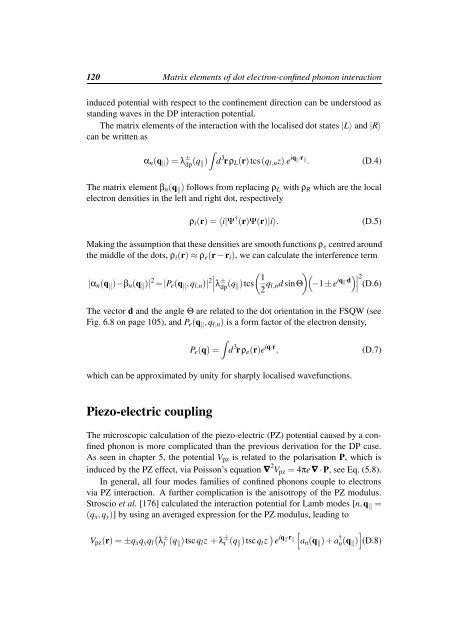Spin-orbit coupling and electron-phonon scattering - Fachbereich ...
Spin-orbit coupling and electron-phonon scattering - Fachbereich ...
Spin-orbit coupling and electron-phonon scattering - Fachbereich ...
You also want an ePaper? Increase the reach of your titles
YUMPU automatically turns print PDFs into web optimized ePapers that Google loves.
120 Matrix elements of dot <strong>electron</strong>-confined <strong>phonon</strong> interaction<br />
induced potential with respect to the confinement direction can be understood as<br />
st<strong>and</strong>ing waves in the DP interaction potential.<br />
The matrix elements of the interaction with the localised dot states |L〉 <strong>and</strong> |R〉<br />
can be written as<br />
Z<br />
α n (q ‖ ) = λ ± dp (q ‖) d 3 rρ L (r)tcs(q l,n z) e iq ‖·r ‖<br />
.<br />
(D.4)<br />
The matrix element β n (q ‖ ) follows from replacing ρ L with ρ R which are the local<br />
<strong>electron</strong> densities in the left <strong>and</strong> right dot, respectively<br />
ρ i (r) = 〈i|Ψ † (r)Ψ(r)|i〉.<br />
(D.5)<br />
Making the assumption that these densities are smooth functions ρ e centred around<br />
the middle of the dots, ρ i (r) ≈ ρ e (r − r i ), we can calculate the interference term<br />
|α n (q ‖ )−β n (q ‖ )| 2 =|P e (q ‖ ,q l,n )| 2∣ ∣ ∣λ<br />
±<br />
dp<br />
(q ‖ )tcs( 1<br />
2 q l,nd sinΘ) (<br />
−1 ± e iq ‖·d )∣ ∣ ∣<br />
2<br />
.(D.6)<br />
The vector d <strong>and</strong> the angle Θ are related to the dot orientation in the FSQW (see<br />
Fig. 6.8 on page 105), <strong>and</strong> P e (q ‖ ,q l,n ) is a form factor of the <strong>electron</strong> density,<br />
Z<br />
P e (q) = d 3 rρ e (r)e iq·r ,<br />
(D.7)<br />
which can be approximated by unity for sharply localised wavefunctions.<br />
Piezo-electric <strong>coupling</strong><br />
The microscopic calculation of the piezo-electric (PZ) potential caused by a confined<br />
<strong>phonon</strong> is more complicated than the previous derivation for the DP case.<br />
As seen in chapter 5, the potential V pz is related to the polarisation P, which is<br />
induced by the PZ effect, via Poisson’s equation ∇ 2 V pz = 4πe ∇ · P, see Eq. (5.8).<br />
In general, all four modes families of confined <strong>phonon</strong>s couple to <strong>electron</strong>s<br />
via PZ interaction. A further complication is the anisotropy of the PZ modulus.<br />
Stroscio et al. [176] calculated the interaction potential for Lamb modes [n,q ‖ =<br />
(q x ,q y )] by using an averaged expression for the PZ modulus, leading to<br />
(<br />
V pz (r) = ±q x q y q l λ<br />
±<br />
l<br />
(q ‖ )tscq l z + λ t ± (q ‖ )tscq t z ) ]<br />
e iq ‖·r ‖<br />
[a n (q ‖ ) + a † n(q ‖ ) (D.8)
















